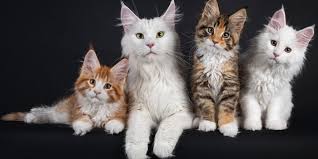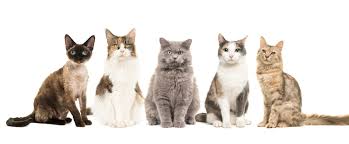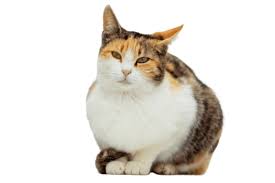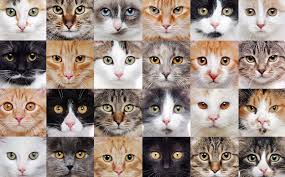Breeds of cats exhibit a remarkable variety in appearance, temperament, and care requirements, making them one of the most popular pets worldwide. These diverse breeds can be categorized into two main groups: purebred and domestic.
Purebred cats, recognized by various cat registries, are bred for specific traits, while domestic cats, often referred to as “moggies,” are mixed breeds that may exhibit an assortment of physical characteristics and personalities.
The history of cat breeding dates back thousands of years, with evidence suggesting that ancient Egyptians revered cats for their hunting skills and companionship. As humans began to selectively breed cats for desirable traits, different breeds emerged, each with its unique set of characteristics.
From the sleek Siamese to the fluffy Persian, each breed has distinct features, such as coat patterns, colors, and body types. For instance, the Maine Coon is one of the largest domesticated cat breeds, known for its long, tufted ears and bushy tail, while the Bengal boasts a striking coat resembling that of a wild leopard.
Additionally, the Scottish Fold is famous for its unique folded ears, giving it a distinctive appearance. These physical traits often influence the breed’s personality and care requirements, making it essential for potential cat owners to research and choose a breed that aligns with their lifestyle.
Beyond appearance, cat breeds also vary significantly in temperament. For example, the Ragdoll is known for its gentle and affectionate nature, making it an ideal companion for families. In contrast, the Abyssinian is typically more active and playful, often requiring more stimulation and engagement from its owners.
Understanding these differences is crucial for potential cat owners to ensure they can meet the social, emotional, and physical needs of their feline companions.
The care and maintenance of different cat breeds can also differ significantly. Some breeds, like the Siamese, have short coats that require minimal grooming, while long-haired breeds, such as the Persian, need regular brushing to prevent matting.
Furthermore, certain breeds may have specific health issues associated with them, making regular veterinary check-ups and a well-balanced diet essential for their well-being.
As cat ownership becomes increasingly popular, so does the interest in understanding the various breeds available. Resources such as breed profiles, owner testimonials, and expert advice can help potential owners make informed decisions.
Adopting a cat involves not only choosing a breed that appeals to one’s aesthetic preferences but also considering factors like energy levels, grooming needs, and compatibility with household members.
Classification of Cat Breeds

Cats are classified into various breeds based on their physical traits, behavior, and history.
1. Purebred Cats: These cats have a documented pedigree and belong to recognized breeds; they often have specific traits and characteristics.
2. Mixed Breed Cats: Also known as domestic cats, these do not belong to a specific breed; they can have diverse physical and behavioral traits.
3. Hybrid Cats: These are a mix between domestic cats and wild cat species; they may have exotic looks and behaviors.
4. Recognized Breeds: Various organizations, like The International Cat Association (TICA) and the Cat Fanciers’ Association (CFA), recognize different breeds based on specific standards.
5. Breed Groups: Cat breeds are often grouped into categories based on characteristics, such as long-haired, short-haired, and hairless cats.
Popular Domestic Cat Breeds
Certain cat breeds are favored for their temperament and companionship.
1. Persian: Known for their long fur and flat faces, Persians are gentle and affectionate.
2. Maine Coon: One of the largest domesticated cat breeds, Maine Coons are friendly, social, and known for their tufted ears.
3. Siamese: Recognized for their striking blue almond-shaped eyes, Siamese cats are vocal and affectionate.
4. Ragdoll: Ragdolls are large, soft cats that enjoy being held; they are known for their calm demeanor and striking blue eyes.
5. Bengal: Bengals have a distinctive spotted coat; they are active, playful, and known for their dog-like behavior.
Read Also: Cutworms: How to Identify and Get Rid of Cutworms
Characteristics of Common Cat Breeds

Each breed has unique characteristics that make them suitable for different lifestyles.
1. Persian: Persians are quiet and prefer a calm environment; they require regular grooming due to their long fur.
2. Maine Coon: Maine Coons are sociable and great with families; they have a playful nature and require regular playtime.
3. Siamese: Siamese cats are highly social and demand attention; they can be quite vocal and enjoy interacting with their owners.
4. Ragdoll: Ragdolls are known for their laid-back personalities; they often go limp when picked up and love to cuddle.
5. Bengal: Bengals are energetic and require mental stimulation; they enjoy climbing and playing, making them suitable for active families.
Rare and Exotic Cat Breeds
Some cat breeds are less common and have unique traits and appearances.
1. Savannah: A hybrid of a domestic cat and a serval, the Savannah is known for its tall, slender build and spotted coat. They are active and require a lot of interaction.
2. Sphynx: Known for its lack of fur, the Sphynx is friendly and social; they enjoy being the center of attention and need regular bathing to keep their skin healthy.
3. Bengal: Bengals resemble small leopards with their striking spots and marbled coats; they are playful and energetic, requiring plenty of stimulation.
4. Peterbald: This hairless breed is known for its elegant build and friendly personality; they are social and often form strong bonds with their owners.
5. LaPerm: Recognized for its curly coat, the LaPerm is affectionate and easygoing; their unique appearance makes them a favorite among cat enthusiasts.
Breeds for Families with Children
Certain cat breeds are known for their friendly and tolerant nature, making them suitable for homes with children.
1. Ragdoll: Ragdolls are gentle and often go limp when picked up; they are affectionate and enjoy being handled, making them great for families.
2. Maine Coon: Maine Coons are known for their friendly disposition and playful nature; they are patient and tolerant, making them ideal for children.
3. Burmese: Burmese cats are social and enjoy interacting with people; they are known for their playful and affectionate behavior, making them great companions for kids.
4. Siamese: Siamese cats are vocal and love to be involved in family activities; they thrive on attention and interaction, making them suitable for families.
5. American Shorthair: This breed is known for its easygoing nature and adaptability; American Shorthairs are friendly and good with children.
Low-Allergen Cat Breeds
For those with allergies, some cat breeds produce fewer allergens than others.
1. Balinese: Often referred to as the “long-haired Siamese,” Balinese cats are known for producing lower levels of allergens, making them suitable for allergy sufferers.
2. Russian Blue: This breed not only has a beautiful blue coat but also produces less Fel d 1, a common cat allergen, making them a good choice for sensitive individuals.
3. Devon Rex: The Devon Rex has short hair and less fur overall, which may result in lower allergen levels; they are playful and affectionate companions.
4. Sphynx: The hairless Sphynx produces less dander, which can be beneficial for allergy sufferers; they are known for their outgoing and friendly nature.
5. Cornish Rex: Similar to the Devon Rex, the Cornish Rex has a short coat and less fur, which can help reduce allergens in the home.
Read Also: 15 Medicinal Health Benefits of Ficus Deltoidea (Misletoea Fig)
Breeds with Distinct Personalities

Some cat breeds are known for their unique personalities and behaviors.
1. Siamese: Siamese cats are known for their vocal and social nature; they love to engage with their owners and can be quite talkative.
2. Abyssinian: Known for their playful and energetic nature, Abyssinians are curious and enjoy exploring their environment; they are very interactive and affectionate.
3. Scottish Fold: With their distinctive folded ears, Scottish Folds are calm and gentle; they are known for their sweet and friendly demeanor.
4. Burmese: Burmese cats are affectionate and social; they often follow their owners around and enjoy being involved in daily activities.
5. Bengal: Bengals are known for their playful and active personalities; they are intelligent and require mental stimulation to keep them engaged.
Health Considerations in Cat Breeds
Different cat breeds come with their own unique health considerations. Understanding these can help you make informed decisions.
1. Persian: Persians are prone to respiratory issues due to their flat face. Regular veterinary check-ups are crucial for monitoring their health.
2. Maine Coon: This breed can be susceptible to hypertrophic cardiomyopathy (HCM), a heart condition. Regular heart screenings can help detect issues early.
3. Sphynx: Sphynx cats are more susceptible to skin problems since they lack fur. Regular bathing and skin care are essential to prevent infections.
4. Scottish Fold: This breed may suffer from cartilage issues due to their folded ears. It’s important to watch for signs of joint pain or mobility issues.
5. Ragdoll: Ragdolls can be prone to certain genetic conditions, including HCM. Regular health checks and maintaining a healthy diet are vital.
Grooming Needs of Different Breeds
Grooming requirements can vary significantly among cat breeds. Understanding these needs will help you maintain your cat’s coat and overall health.
1. Persian: Persians require daily grooming to prevent matting and tangles in their long fur. Regular brushing also helps reduce shedding.
2. Bengal: Bengals have a short, dense coat that requires minimal grooming. Weekly brushing is usually sufficient to keep their coat healthy.
3. Maine Coon: This breed has a thick coat that needs regular grooming. Brush them at least two to three times a week to prevent matting and hairballs.
4. Sphynx: While they don’t have fur, Sphynx cats require regular bathing to remove excess oil from their skin. Weekly baths help maintain their skin health.
5. Devon Rex: The Devon Rex has short hair and requires less grooming. A gentle rub with a damp cloth can keep their coat looking clean and healthy.
Choosing the Right Cat Breed for Your Lifestyle
Selecting a cat breed that aligns with your lifestyle is crucial for a happy and fulfilling companionship.
1. Activity Level: Consider your activity level. If you’re active and enjoy playtime, breeds like Bengals and Abyssinians are energetic and require engagement.
2. Space: Evaluate your living space. Larger breeds like Maine Coons may need more room to roam, while smaller breeds like the Singapura can adapt to smaller living environments.
3. Allergies: If you or someone in your home has allergies, consider low-allergen breeds like the Balinese or Sphynx, which produce fewer allergens.
4. Time Commitment: Some breeds, like Persians, require more grooming and care, while others, like American Shorthairs, are more low-maintenance. Choose a breed that fits your schedule.
5. Family Considerations: If you have children or other pets, look for friendly and tolerant breeds such as Ragdolls or Burmese, which tend to get along well with families.
Do you have any questions, suggestions, or contributions? If so, please feel free to use the comment box below to share your thoughts. We also encourage you to kindly share this information with others who might benefit from it. Since we can’t reach everyone at once, we truly appreciate your help in spreading the word. Thank you so much for your support and for sharing!
Read Also: Six Health Benefits of Sugarcane Juice

